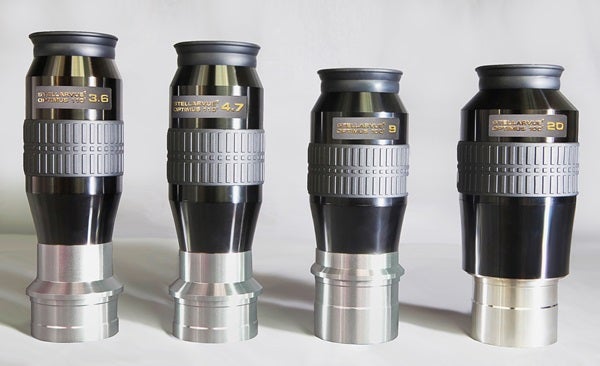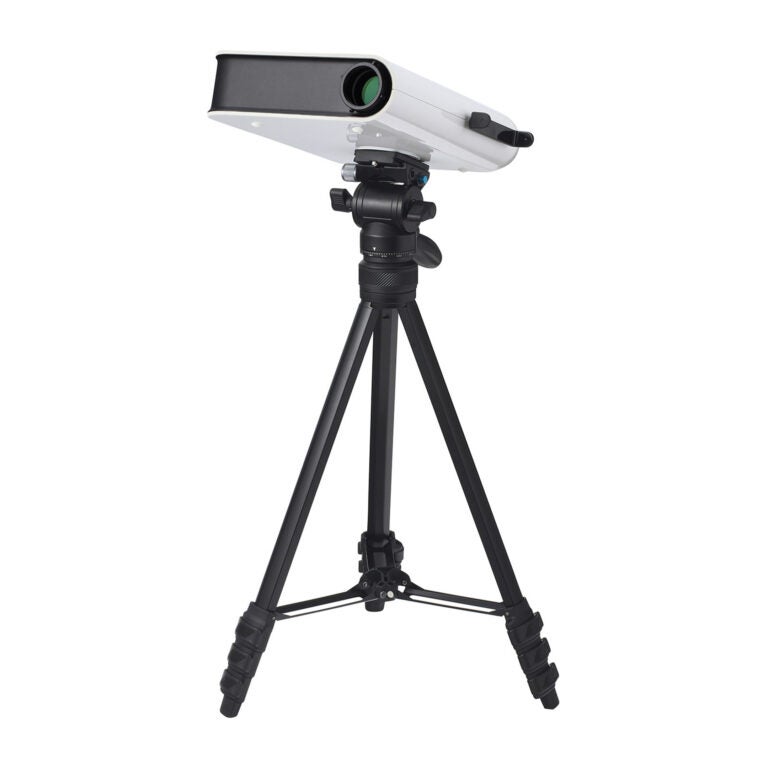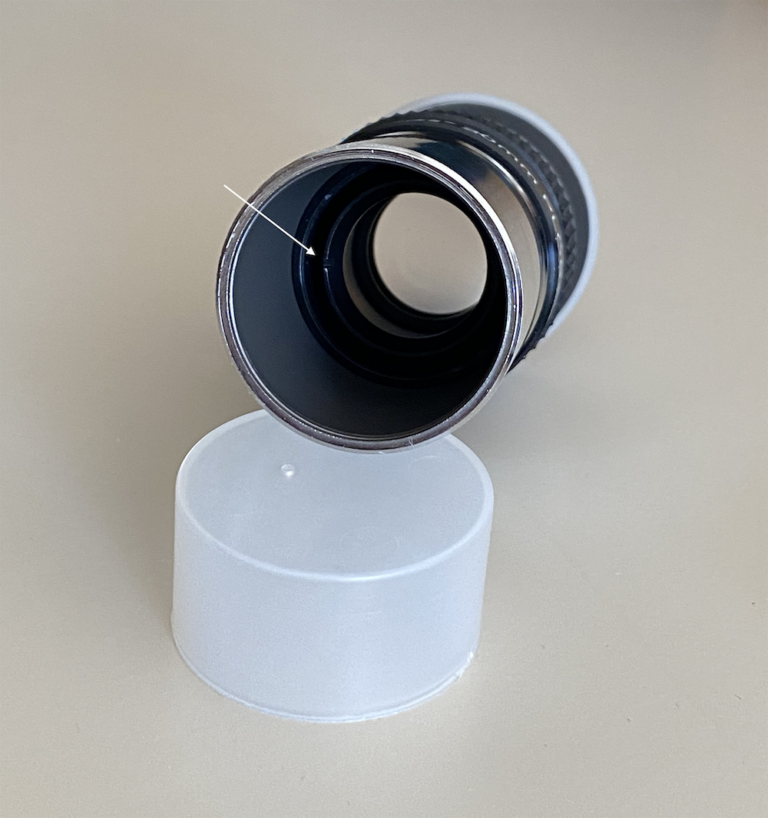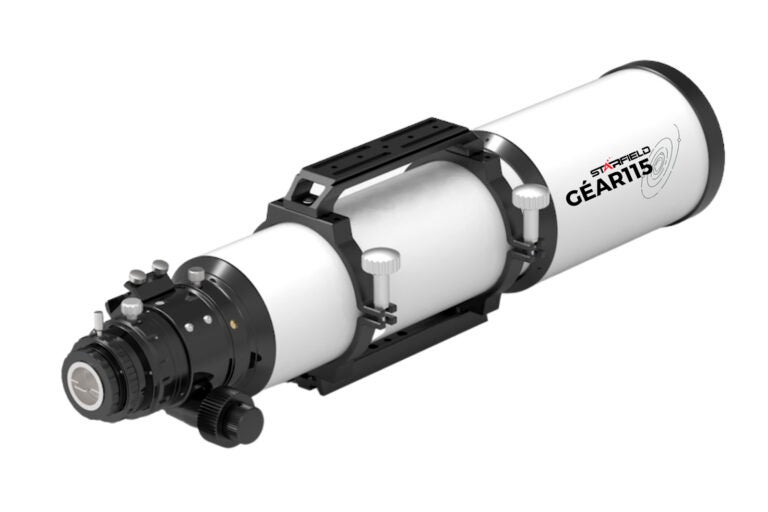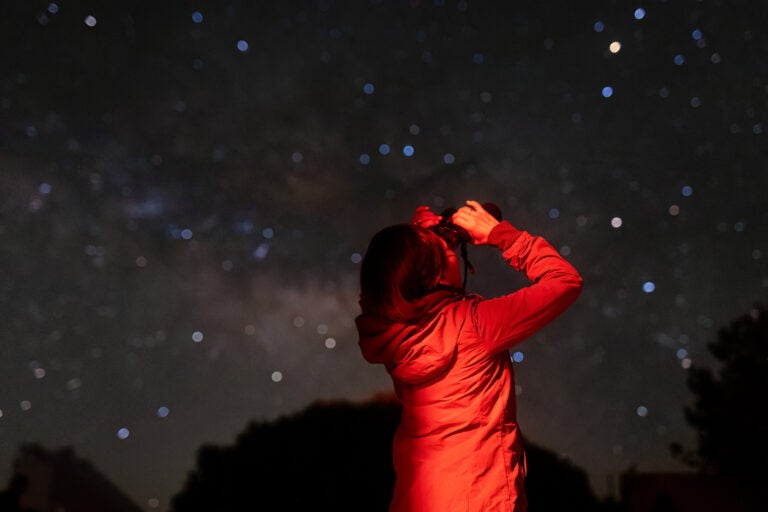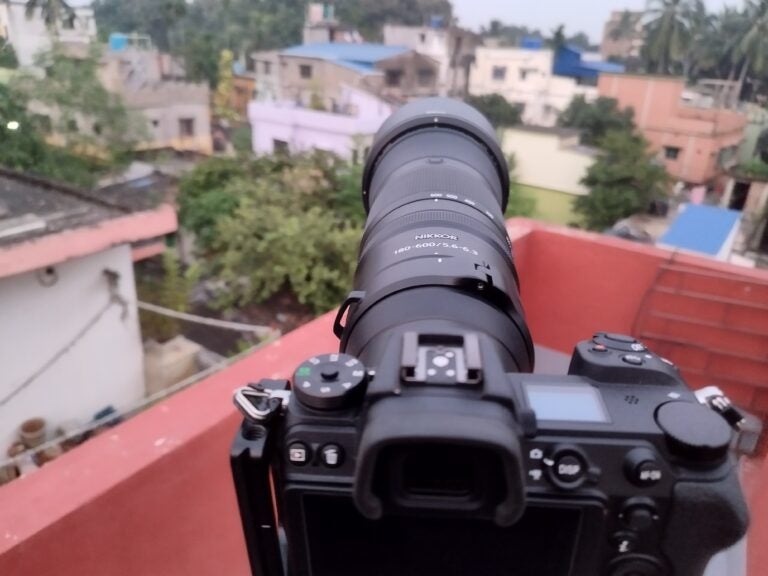The current Stellarvue lineup features 9mm and 20mm models with 100° apparent fields of view and 3.6mm and 4.7mm versions that sport 110° fields. The company plans to introduce a 13mm 100° version in 2017. All eyepieces come with 1¼”-to-2″ adapters except the 20mm, which only fits a 2″ focuser.
A general look
To achieve his goal, Maris spent several years working with the company he chose to manufacture them. And as you read on, you’ll see that the end product justified the time and effort spent.
All the eyepieces feature extreme broadband coatings on each glass surface to enhance light throughput and image contrast; special edge-blackening to minimize reflections and increase contrast; tight tolerances on polishing the glass to enhance performance; precision machining to the eyepiece’s body to make it easy to handle at night; high-grade rubber for the grips and eye cups to enhance longevity; sealed field and eye lenses to keep moisture out under normal use; and gold badges to designate their focal lengths.
Add all these up, and you get sharp contrasty views right to the edge of the field. Maris designed the eyepieces primarily for refractors, but they also work well with Newtonian reflectors if you add a coma corrector. That additional optic eliminates the defect called coma, which makes stars near the edge of the field of view resemble comets. Using such a device with a fast (short focal ratio) reflector will give pinpoint stars to the edge of the field of view.
Tech timeout
Beyond how well these eyepieces work, I also wanted to know how they work. So, I contacted Roger Ceragioli, an optician and lens designer at the Steward Observatory Mirror Lab, which is part of the University of Arizona. Here’s what he told me.
Super wide eyepieces typically have three functional lens groups. The field group (the one at the front of the eyepiece) is usually a multi-element Barlow lens, sometimes called a Smyth lens. This diverges the incoming light rays and counteracts errors inevitably introduced later in the eyepiece.
Next comes a thick meniscus lens, positioned just before the eyepiece’s internal field stop. Its purpose is to broaden and flatten the focal surface (field of view).
The third group (at the eye end) comes after the field stop and strongly converges the light cones into parallel bundles. They then move into the exit pupil (where the eyeball goes) at a steep angle to create the visual wide-angle effect.
Comparing eyepieces is tricky business because many factors come into play. Seeing, transparency, and the quality of the telescope all can affect how a person judges their performance. Therefore, I always test eyepieces over several nights with rested eyes to make sure I’m using a level playing field.
During the last Stellarvue Star Party at Likely Place Golf and RV Resort in California, we put a 20mm 100° Optimus eyepiece into my 24-inch f/3.85 Newtonian reflector and added a coma corrector. The popular consensus: “best views ever” of everything we looked at. The wide field of view, combined with pinpoint sharpness, great light throughput, and high contrast, made the Optimus a winner.
But what exactly did that consensus mean? In one instance, we compared the 20mm Optimus to a famous-brand 20mm eyepiece of slightly different (but still wide field) design. Despite the fact that the Optimus had larger true and apparent fields of view, brightness and contrast of objects were as good or better through it compared with the other eyepiece. Furthermore, with a coma corrector at exactly the right setting, stars were pinpoints all the way to the edge. This enhanced the feeling that we were looking through a porthole on a spaceship.
To give you an idea of what some famous, and often viewed, objects look like through this eyepiece, I made some notes. Some of these are my impressions, and others come from various seasoned observers.
The Andromeda Galaxy (M31) is like nothing I have ever seen before. The wide-field view of the dark lanes is jaw-dropping. They look like railroad tracks planted in front of the galaxy. The ethereal light coming from the nucleus is so bright you lose your dark adaption.
When we swung the telescope toward NGC 206, this star cloud within the galaxy became pronounced. But then the real fun began — many of the star clouds and dark lanes were clearly visible as the galaxy wrapped around itself. You actually could trace the curved end of the galaxy. The 20mm Optimus kept things bright but also magnified the image enough so that small details became visible.
After I attached a UHC filter (which increases contrast by darkening the sky background), the Swan Nebula (M17) looked as though it was illuminated by fluorescent lights. Mottling was obvious as well as many arcs of faint stars. Once again, the pinpoint stars to the edge of the field greatly enhanced the porthole illusion.
The Lagoon Nebula (M8) appeared to be a seething cauldron of light punctuated by dark lanes and bundles of stars. First-time viewers gasped when they saw this sight, hardly imagining anything like this was possible. Like the wizard behind the scenes, however, it was the Optimus 20mm combined with the coma corrector that was the real showpiece.
But what about more subtle views — say, the Crescent Nebula (NGC 6888)? For this one, I selected an Oxygen-III filter to pair with the Stellarvue eyepieces. Whereas the other objects were “in your face,” the Crescent showed how the Optimus could deliver on more rarified subject matter. The view revealed a softly glowing nebula surrounded by stars, an ethereal view again enhanced by the large field of view.
Once again using the OIII filter, I aimed the scope at the Veil Nebula (NGC 6960/74/79/92–95) in Cygnus. Everyone saw both sides of it bright and well defined with sinuous strands everywhere. The part of the nebula close to the bright star 52 Cygni was especially poignant, looking like some piece of translucent coral that branched off into the Witch’s Broom area.
Love at first sight
In a nutshell, the four eyepieces in Stellarvue’s Optimus series have become my go-to eyepieces for viewing larger celestial targets. I look forward to winter views of the Orion Nebula (M42) and the Rosette Nebula (NGC 2237–9/46) and springtime views of galaxy clusters. Once you get used to them (and this doesn’t take long), you will not be satisfied with ordinary views ever again.
These eyepieces represent a significant breakthrough in performance for cost. The views through them of common and uncommon celestial targets were jaw-dropping. In every case, whichever Optimus I selected delivered superb definition and sharpness to the edge of the field. To Vic Maris and Stellarvue I can only say: Mission accomplished!

